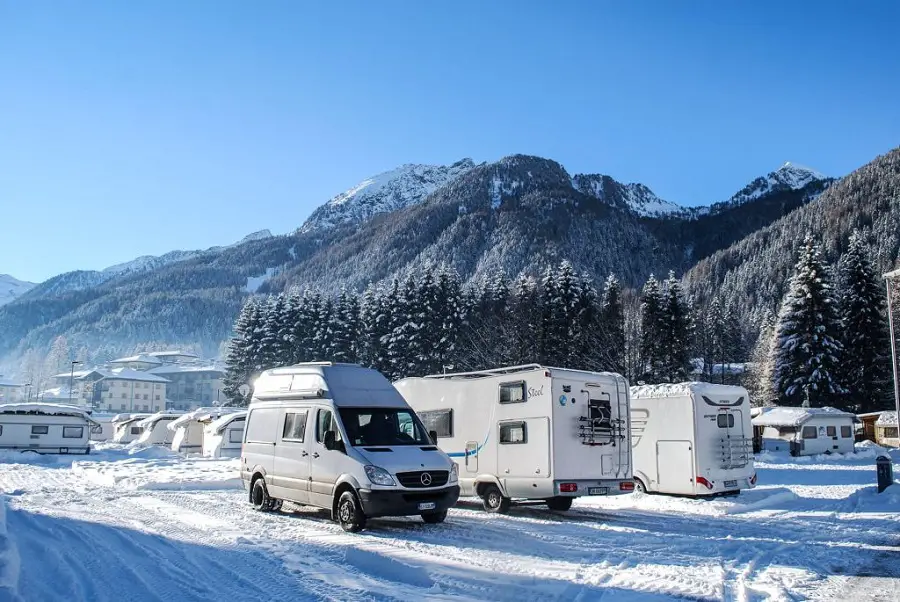Many of us choose to use our RV or camper all year long—not just during peak travel season. If you’re one of those who continues traveling regardless of the season or even lives year-round in your RV or camper, you may benefit from the following information.
Whether it’s making the most of your heating element or avoiding drafts, these 16 tips can help you weather out the winter—while enjoying every minute of it.
1. Invest In Vent Pillows
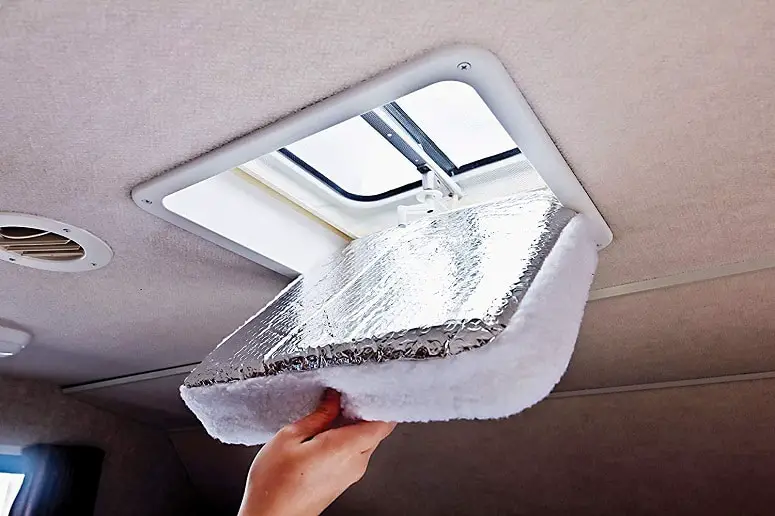
Maybe you have never heard of vent pillows, or maybe it’s just never occurred to you to use them. Investing in pillows like this Vent Insulator, to insert in your vents can keep your RV warmer during cold weather.
The bonus is that these same pillows will help keep you cool during hot weather as well.
Vents are a great feature to have in an RV. They help provide airflow and light. The problem is those same vents can let the outside air in when you don’t want it to.
Whether you’re talking about very cold or very hot weather, the result is the same—your interior temperature becomes uncomfortable.
A pillow placed inside the vent provides extra insulation that will help stop that from happening. Check out this video to see how it works.
When the weather is good and you want a nice breeze—or in the winter during a warm day where you could use some fresh air—simply remove the pillow. Replace when the weather turns.
2. Utilize A Space Heater—Properly

Space heaters have got a bad reputation for being hazardous. The truth is, people frequently choose to use them in ways that are not safe. Used properly, a space heater can be a great way to ward off the winter chill in your RV.
Invest in a quality space heater to use while you’re awake and onsite. Even a small space heater will make a tremendous difference in your comfort level.
It can provide you with the additional heat you crave, while also lowering your winter propane heating costs.
It’s best to purchase a space heater with a safety mechanism built in. Look for one that automatically turns off after a prolonged period of time, and has an automatic shut off if it’s knocked over. Always opt for a fully enclosed system.
Don’t choose your space heater from the bargain bin. Select one that costs a little more for the effectiveness and safety features that you and your RV deserve.
3. Warm Yourself From The Inside Out

Keep a stash of your favorite teas and coffees handy. If you have a soft spot for hot chocolate made with fresh milk, have a supply of that as well.
It’s tempting to reach for a heating element when you feel a little chilled. Rather than cranking up the temperature, however, make yourself a hot beverage and settle down with your favorite cozy blanket.
The warm drink will take the edge off the cold while not making an impact on your heating expenditure or resources.
Choose the drinks you can’t live without. It can be an expensive tea you purchase by the tin at a specialty shop, or a pod system—or coffee you can find at any convenience store.
Whatever you find warms your core will help ward off the chilliest moments in your RV.
4. Don’t Skimp On Blankets
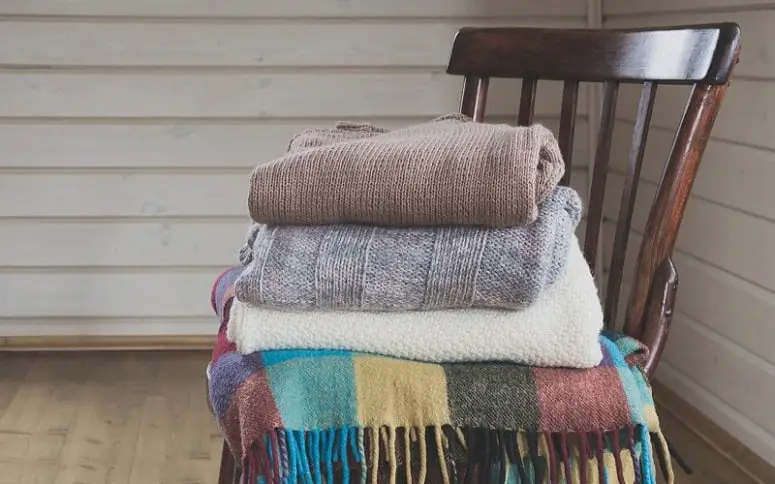
Blankets are a simple way to keep warm when the temperature drops. It’s also one that’s easy to overlook, or even to consider impractical in the small space of an RV.
Look for blankets without a lot of loft. Quilts with natural cotton or wool batting can be a great thing to bring along. Not only are they warm without taking up much space, but they’re also easy to layer.
Space is always a concern when you’re in an RV. Bringing blankets doesn’t mean you need to sacrifice your precious space though.
Layer directly on your bed and sleep on top of what you don’t need—or invest in space-saving storage bags to pack as compactly as possible.
Not a quilter? Don’t overlook flea markets, thrift stores, and antique shops for great sources for well-made vintage quilts.
Pick them up while you’re on your RV adventure and not only will you be warm, but each blanket will have a story of its own to share.
5. Play To The Sun
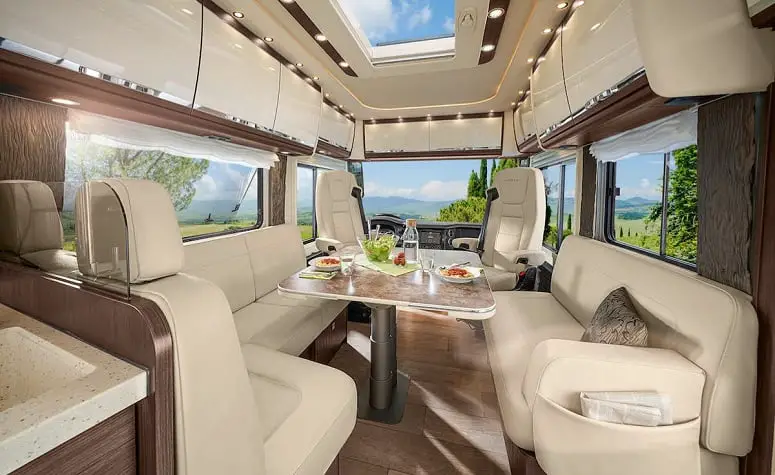
If you have windows facing the sun, leave those shades up to let light and warmth in. Even if it’s only for a few hours a day, it can make a tremendous difference in both your mindset and the physical temperature of your RV.
Pull the shades down on any other windows on the opposite side to help keep out the cold.
Don’t underestimate the importance sunlight has in making you feel warm. A little bit of sun can go a long way toward helping you feel like you’re escaping the winter.
Heavy drapes can also be used to prevent the chills from seeping in through the RV windows.
These can even be attached easily with hook and loop closures. Have them on every window, and close them firmly once the sun sets.
6. Check Your Exterior

It’s easy to focus on what you can do inside your camper to help make things a little warmer. Don’t forget the importance of keeping your camper structurally sound from the cold as well.
Before winter begins, take a good look at the exterior of your RV or camper. Make sure there are no obvious areas that need to be repaired, and check for any windows that need to be re-caulked, or re-sealed with putty tape or similar.
Don’t forget to evaluate the weather stripping on your doors and windows as well. These are simple, inexpensive fixes that can make a world of difference on how your RV or camper makes its way through the winter.
7. Come Prepared
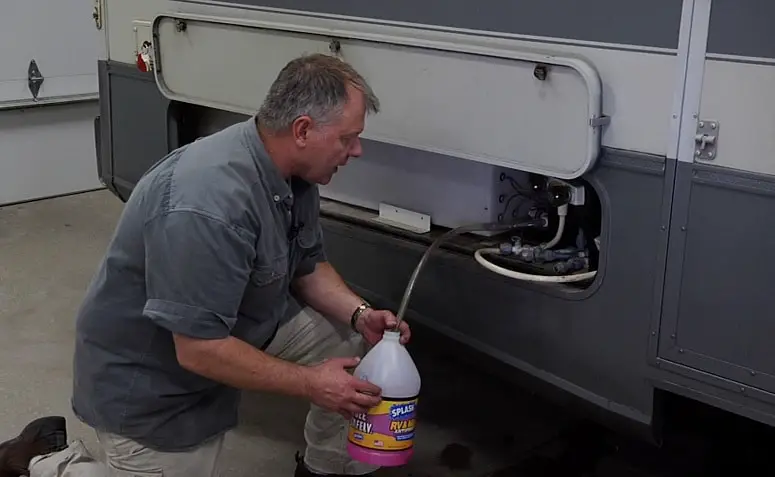
If you’re wintering in a place where the weather is more than just cool, but can be unpredictable and even dangerous, make sure your RV is fully prepared for any and all emergencies that can happen.
AAA’s Winter Checklist covers just about everything you need. This means taking stock of where your water sources are located and how you can prevent them from freezing.
Your water hose and tank may both be susceptible. Plan accordingly, to prevent them from becoming nonfunctional in cold weather.
Your best bet would be to have a small space heater on hand for your tank or to invest in a heated water hose. In a pinch, you can physically insulate to the best of your ability, using what you have inside the RV.
However, planning to be prepared for all extremes will put you in a better position to successfully get through the winter in your RV.
8. Expect Road Emergencies
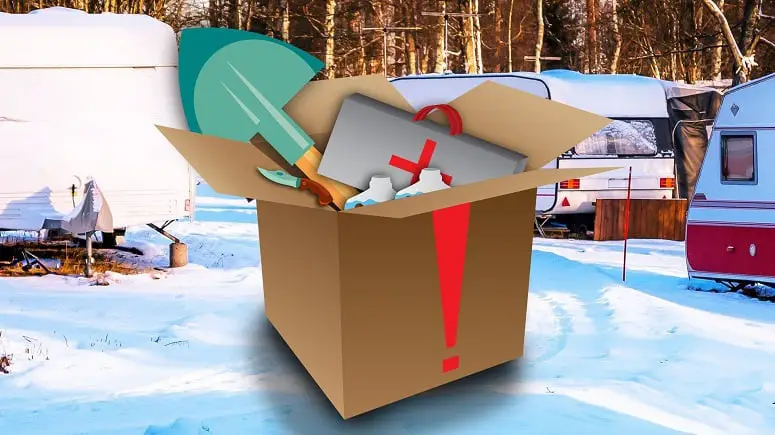
It’s unlikely that you’ll be spending your entire winter at a single site. Not only do you need to be prepared for winter emergencies that happen while you’re at camp, but you should also be ready to deal with roadside emergencies as well.
Create an emergency kit that can be helpful for bad weather travel. A bag of kitty litter or sand, snow chains, and wood to stabilize jacks can all be unbelievably helpful when RVing during the worst of winter’s weather.
Don’t be afraid to extend your stay at a certain location if the weather looks bad. If prematurely calling it a day is an option when the weather turns while you’re driving, do yourself a favor and stop.
Remember, there’s no need to hurry and the risk isn’t worth it.
9. Bring A Skirt
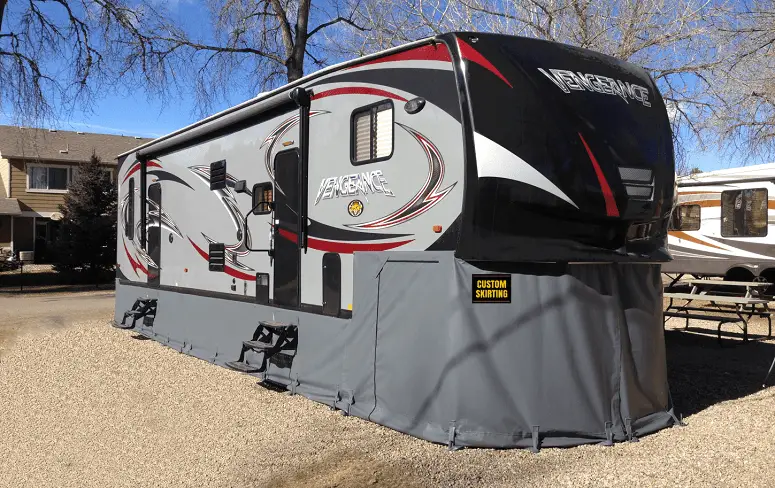
If you’re using an RV without insulated bays, or if you’re pulling a trailer, you may want to consider skirting your vehicle during extreme winter weather.
Winter RVing can be amazing, but many RVs and campers just aren’t made for the experience. A skirt can help protect the vulnerable equipment underneath your RV.
Make sure you choose a company that’s well-versed in skirting, preferably in an area that receives a significant amount of snow and has real experience.
You can have your skirt professionally installed or you can choose to install it yourself – check out this video.
If you can’t get your skirting set up in time, you could build a wall of snow around the exterior of the base. This will help keep cold air from moving beneath the carriage.
10. Expose What Water Pipes You Can
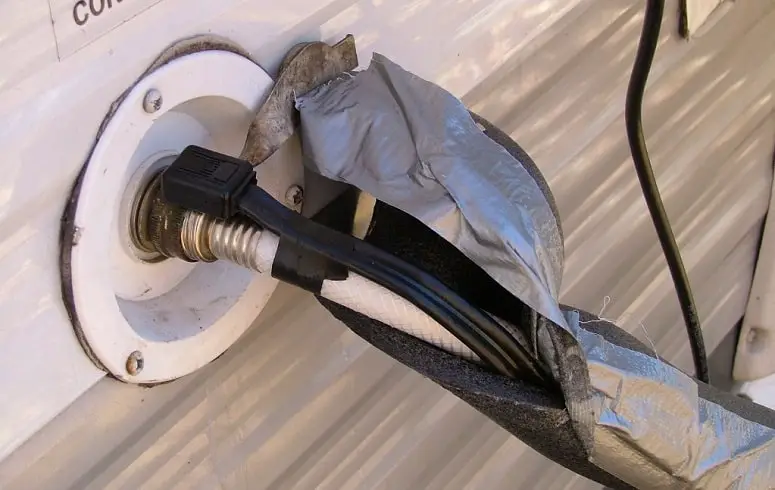
When the temperatures drop outside, remember that your water lines inside are in danger of freezing. Leaving open the cabinetry around those lines can keep the pipes exposed to warm air and help stop them from freezing.
Position a space heater nearby if you’re concerned that having the cabinets open won’t be enough. The area around the pipe doesn’t necessarily have to be warm to prevent the pipe from freezing.
Remember to follow safety protocols when using a space heater. Depending on the water system you have set up in your RV or camper, you may also opt to leave your faucets dripping.
Commonly done in a house situation, it’s not always as practical when you’re on the road—especially if your water sources are limited.
It’s always good to travel with a hairdryer. Should an area of the line unexpectedly freeze, a hairdryer like this can help defrost the compromised piping.
11. Open Your Door Only When Necessary

Opening the door to your living space can let in a lot of cold air. While it may be only a matter of moments, it will take your RV a long time and a lot of energy to recoup the heat that’s lost.
Avoid wasting energy and subjecting your RV to cooler temperatures, by making the most out of each trip in and out of the RV.
Schedule your outings to take advantage of the warmest parts of the day and don’t keep the door open any longer than necessary.
If you’re bringing in loads of supplies, work together to minimize the time the door is open and to hurry belongings to their final destination.
12. Pack Electric Blankets

An electric blanket can be a quick fix for warming you up. Tucked under one while in your RV reading and relaxing can help you feel warm, even if the ambient temperature is cooler than you usually find comfortable.
Electric blankets are a great addition to your quilt stash. They’re portable and can be moved easily around the RV. You can even add them to your stack of blankets at bedtime.
These blankets are easy to use, simple to store, and most importantly of all, incredibly effective. If you’ve been looking for a good way to stay warm this winter in your RV, an electric blanket is a great place to start .
13. Travel With Painter’s Tape
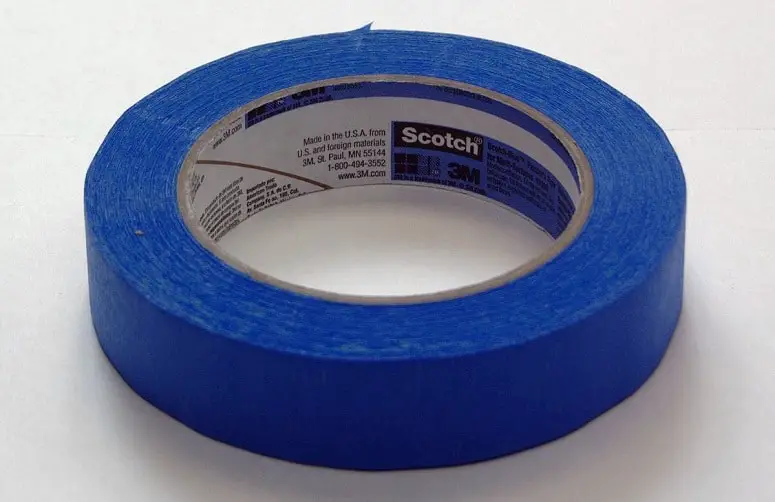
Even if you think you’ve caught every leak your RV has to offer, once you’re in the middle of winter, you may find that you’ve missed a spot… or two.
In a pinch, painter’s tape can be used to seal up those annoying leaks. They’ll do a decent job at stopping the draft, and when you find you can apply a more permanent fix, the tape won’t leave behind any destructive residue.
Painter’s tape is like duct tape—it’s great to have aboard, takes up little storage space, and you’ll be surprised by how many uses you can find for it. Do yourself a favor and pack both for your winter RVing experience.
14. Area Rugs And Runners
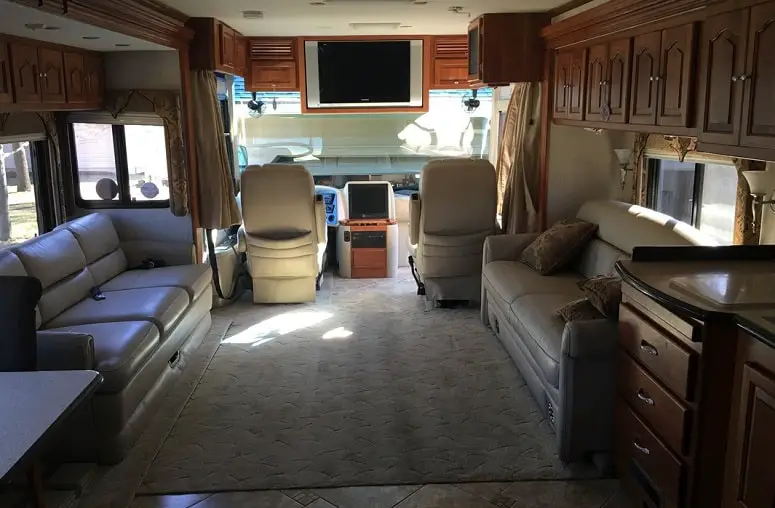
Don’t overlook the importance of everyday comforts. Including area rugs in your RV can help prevent drafts from seeping up from underneath the floor.
Not only will this help cut down on drafts and keep your feet warm, but it will also protect your RV from any dampness you’ll inevitably bring inside.
Make sure to keep a shoe tray somewhere accessible to collect melting snow and debris. Your area rugs will help your interior last longer and keep the winter weather at bay.
Have fun with your rug selection and add some personality to your space. You might find a little punch of color and fun will ease the drabness that stretches of long, dull winter weather can bring.
If you tire of them or they wear during the season, they’re inexpensive enough to replace the following year.
Make sure your rug is safe—if it doesn’t have a textured backing, buy one separately. The last thing you want to do is slip and fall in your RV during bad weather.
15. Shrink Wrap

Do-it-yourself shrink wrap kits for windows and doors are extremely affordable. Though they may be tedious and time-consuming to set up, they make a significant difference in stopping drafts.
Follow the instructions included in your shrink wrap kit. Simply apply as directed to your door and windows. Once in place, use a handheld heating implement (another great time to pull out your hairdryer) and the plastic shrinks to fit.
When wind seeps in through the door or window, it’s stopped by plastic, reducing the coolness that makes its way inside. Didn’t think it would be effective? Simply watch the way the plastic moves with each gust of wind that batters the exterior.
For the price, shrink wrapping vulnerable areas offers a great value to effectiveness ratio. It can make a world of difference in keeping your RV warm and comfortable this winter.
16. Bring A Dehumidifier
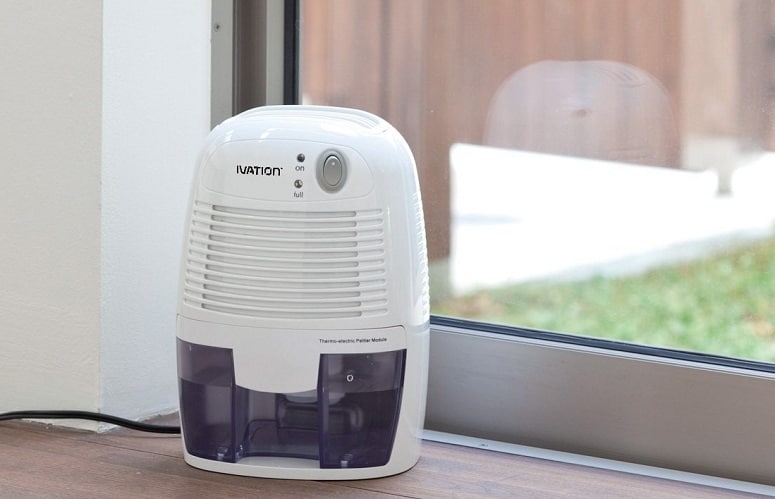
It may seem counter-intuitive while you’re trying to up the inside temperature, but a dehumidifier can be a great asset during winter travel.
Moisture is the enemy. Keeping it out will help your place stay warm and comfortable. Letting it in can allow damp, mold, and discomfort.
You’ve done your best to block all the drafts, but that increase in insulation also helps prevent moisture from escaping.
You’ll notice it mostly on your windows. Condensation. It’s usually an indication that there’s not enough airflow happening to create a healthy atmosphere.
During the winter, though, you can’t achieve the appropriate ratio without compromising the inside temperature.
Cutting down on that condensation is critical. A dehumidifier can help capture that excess moisture and make it easy to dispose of.
You’ll be keeping your space both warmer and healthier with barely any effort and without compromising your comfort.
Pack Your Things And Get Ready For The Winter Of A Lifetime
A little bit of prep work can have you and your RV ready to handle whatever winter can throw at you.
Tackle your to-do list piece by piece and, in no time at all, you’ll be more than ready to hit the road in style—all while remaining warm, happy, and comfortable.
We hope you’ve enjoyed this list and found it helpful. If there’s something we’ve missed here, we’d love to hear about it—it will make our winter travels more comfortable as well.
Share your approach in the comments below and everyone will be better for it in the coming months.


